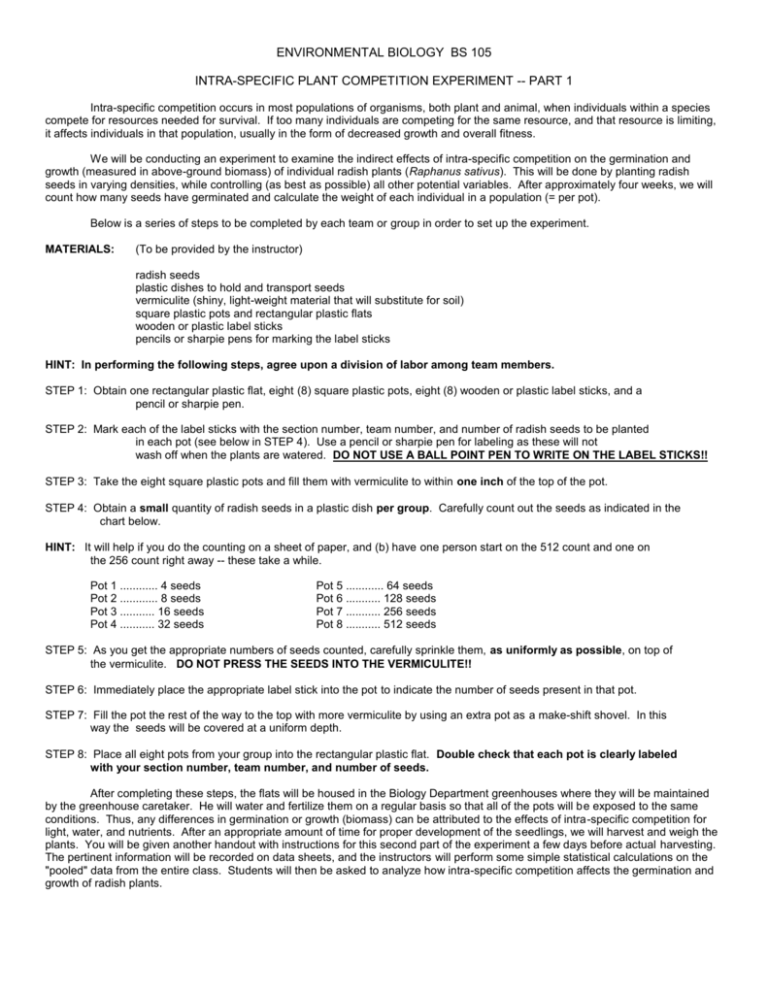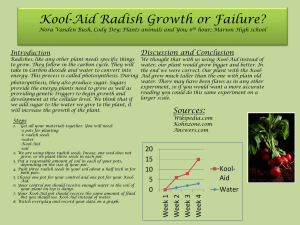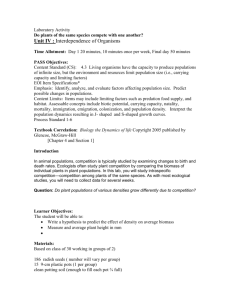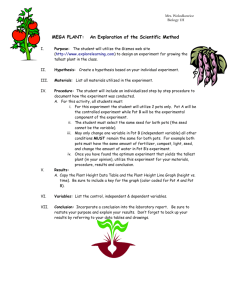ENVIRONMENTAL BIOLOGY BS 105
advertisement

ENVIRONMENTAL BIOLOGY BS 105 INTRA-SPECIFIC PLANT COMPETITION EXPERIMENT -- PART 1 Intra-specific competition occurs in most populations of organisms, both plant and animal, when individuals within a species compete for resources needed for survival. If too many individuals are competing for the same resource, and that resource is limiting, it affects individuals in that population, usually in the form of decreased growth and overall fitness. We will be conducting an experiment to examine the indirect effects of intra-specific competition on the germination and growth (measured in above-ground biomass) of individual radish plants (Raphanus sativus). This will be done by planting radish seeds in varying densities, while controlling (as best as possible) all other potential variables. After approximately four weeks, we will count how many seeds have germinated and calculate the weight of each individual in a population (= per pot). Below is a series of steps to be completed by each team or group in order to set up the experiment. MATERIALS: (To be provided by the instructor) radish seeds plastic dishes to hold and transport seeds vermiculite (shiny, light-weight material that will substitute for soil) square plastic pots and rectangular plastic flats wooden or plastic label sticks pencils or sharpie pens for marking the label sticks HINT: In performing the following steps, agree upon a division of labor among team members. STEP 1: Obtain one rectangular plastic flat, eight (8) square plastic pots, eight (8) wooden or plastic label sticks, and a pencil or sharpie pen. STEP 2: Mark each of the label sticks with the section number, team number, and number of radish seeds to be planted in each pot (see below in STEP 4). Use a pencil or sharpie pen for labeling as these will not wash off when the plants are watered. DO NOT USE A BALL POINT PEN TO WRITE ON THE LABEL STICKS!! STEP 3: Take the eight square plastic pots and fill them with vermiculite to within one inch of the top of the pot. STEP 4: Obtain a small quantity of radish seeds in a plastic dish per group. Carefully count out the seeds as indicated in the chart below. HINT: It will help if you do the counting on a sheet of paper, and (b) have one person start on the 512 count and one on the 256 count right away -- these take a while. Pot 1 ............ 4 seeds Pot 2 ............ 8 seeds Pot 3 ........... 16 seeds Pot 4 ........... 32 seeds Pot 5 ............ 64 seeds Pot 6 ........... 128 seeds Pot 7 ........... 256 seeds Pot 8 ........... 512 seeds STEP 5: As you get the appropriate numbers of seeds counted, carefully sprinkle them, as uniformly as possible, on top of the vermiculite. DO NOT PRESS THE SEEDS INTO THE VERMICULITE!! STEP 6: Immediately place the appropriate label stick into the pot to indicate the number of seeds present in that pot. STEP 7: Fill the pot the rest of the way to the top with more vermiculite by using an extra pot as a make-shift shovel. In this way the seeds will be covered at a uniform depth. STEP 8: Place all eight pots from your group into the rectangular plastic flat. Double check that each pot is clearly labeled with your section number, team number, and number of seeds. After completing these steps, the flats will be housed in the Biology Department greenhouses where they will be maintained by the greenhouse caretaker. He will water and fertilize them on a regular basis so that all of the pots will be exposed to the same conditions. Thus, any differences in germination or growth (biomass) can be attributed to the effects of intra-specific competition for light, water, and nutrients. After an appropriate amount of time for proper development of the seedlings, we will harvest and weigh the plants. You will be given another handout with instructions for this second part of the experiment a few days before actual harvesting. The pertinent information will be recorded on data sheets, and the instructors will perform some simple statistical calculations on the "pooled" data from the entire class. Students will then be asked to analyze how intra-specific competition affects the germination and growth of radish plants.







